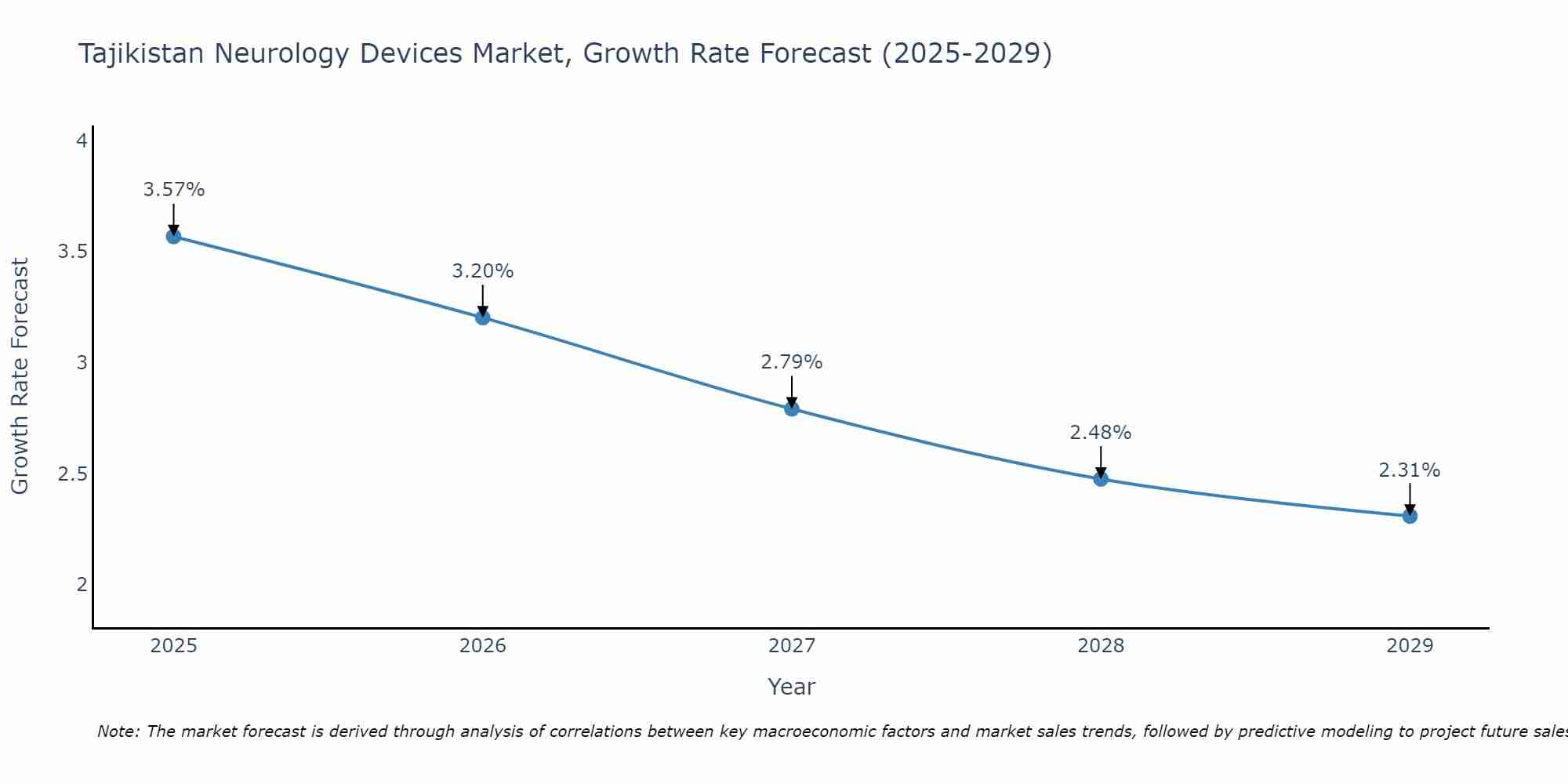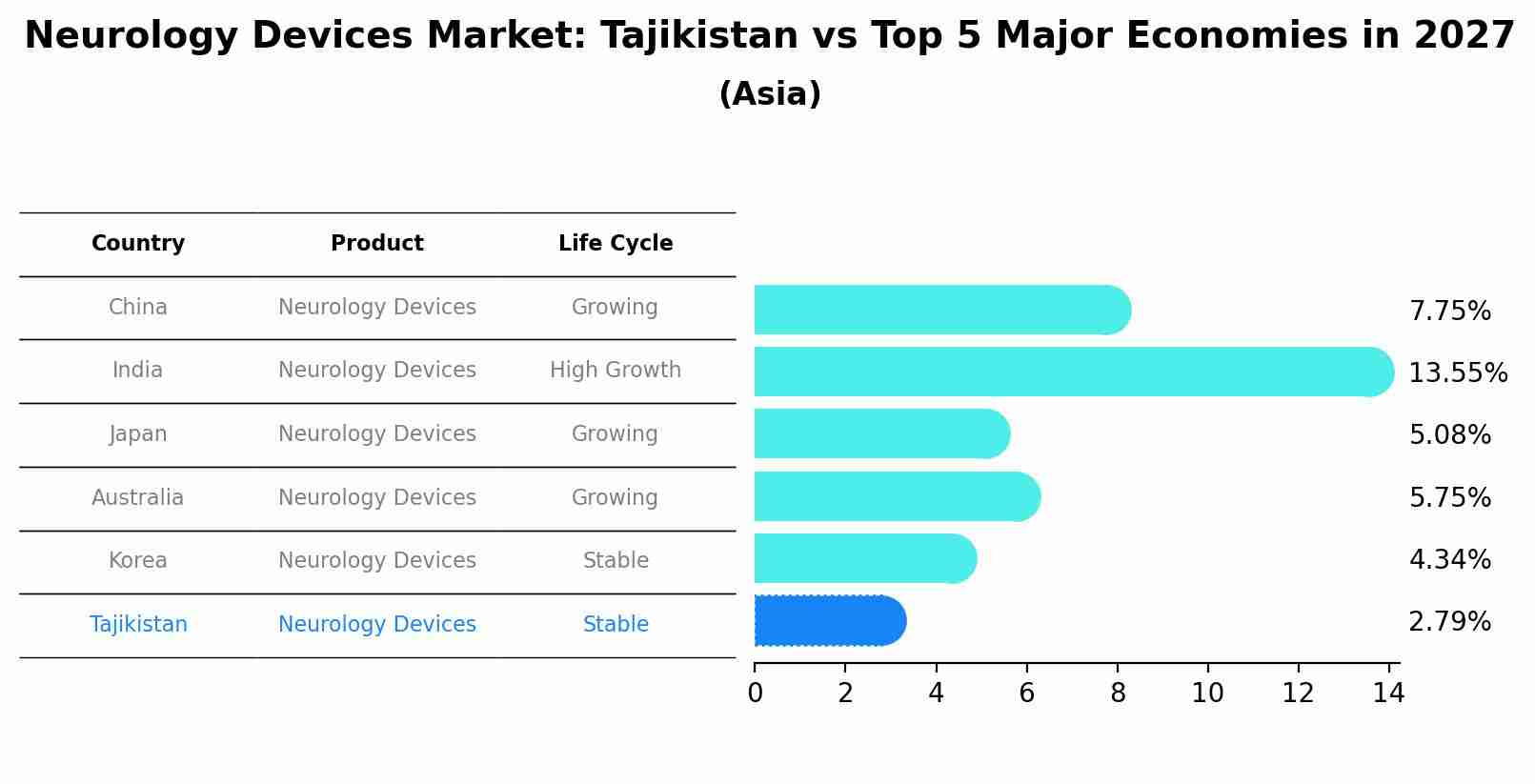Tajikistan Neurology Devices Market (2025-2031) Outlook | Trends, Size, Share, Companies, Revenue, Value, Forecast, Growth, Industry & Analysis
| Product Code: ETC367679 | Publication Date: Aug 2022 | Updated Date: Jul 2025 | Product Type: Market Research Report | |
| Publisher: 6Wresearch | Author: Shubham Deep | No. of Pages: 75 | No. of Figures: 35 | No. of Tables: 20 |
Tajikistan Neurology Devices Market Size Growth Rate
The Tajikistan Neurology Devices Market could see a tapering of growth rates over 2025 to 2029. Beginning strongly at 3.57% in 2025, growth softens to 2.31% in 2029.

Neurology Devices Market: Tajikistan vs Top 5 Major Economies in 2027 (Asia)
The Neurology Devices market in Tajikistan is projected to grow at a stable growth rate of 2.79% by 2027, highlighting the country's increasing focus on advanced technologies within the Asia region, where China holds the dominant position, followed closely by India, Japan, Australia and South Korea, shaping overall regional demand.

Tajikistan Neurology Devices Market Synopsis
The Tajikistan Neurology Devices Market is a growing sector driven by increasing awareness of neurological disorders and the rising demand for advanced medical technologies in the country. The market offers a range of neurology devices such as EEG machines, neurostimulation devices, neurosurgical instruments, and diagnostic equipment. The key factors influencing market growth include a growing elderly population, rising incidence of neurological disorders, and government initiatives to improve healthcare infrastructure. However, challenges such as limited access to advanced medical facilities in rural areas and the high cost of neurology devices may hinder market expansion. Overall, there is significant potential for market players to invest in this sector and introduce innovative technologies to meet the growing healthcare needs in Tajikistan.
Tajikistan Neurology Devices Market Trends
The Tajikistan Neurology Devices Market is witnessing a growing demand for advanced technologies such as neurostimulation devices, neurosurgical navigation systems, and brain monitoring devices. Increased awareness about neurological disorders and the rising prevalence of conditions like epilepsy, stroke, and Parkinson`s disease are driving the market growth. The government`s initiatives to improve healthcare infrastructure and the availability of reimbursement policies for neurology devices are also contributing to market expansion. Additionally, the adoption of telemedicine and remote monitoring solutions in neurology practices is gaining traction, especially in rural areas where access to specialized healthcare services is limited. Overall, the Tajikistan Neurology Devices Market is poised for steady growth in the coming years as healthcare providers prioritize the diagnosis and treatment of neurological conditions.
Tajikistan Neurology Devices Market Challenges
In the Tajikistan Neurology Devices Market, some key challenges include limited access to advanced technology and equipment, inadequate healthcare infrastructure and resources, as well as a shortage of skilled healthcare professionals specializing in neurology. Additionally, regulatory hurdles and lack of awareness about the latest neurology devices among both healthcare providers and patients present obstacles to market growth. The country`s economic constraints and low healthcare expenditure also contribute to the challenges faced in this market. Addressing these issues will require investments in healthcare infrastructure, training programs for healthcare professionals, and awareness campaigns to promote the benefits of neurology devices, ultimately fostering market development in Tajikistan.
Tajikistan Neurology Devices Market Investment Opportunities
In Tajikistan, the Neurology Devices Market presents promising investment opportunities due to the growing prevalence of neurological disorders and the increasing focus on healthcare infrastructure development. Investors can consider opportunities in the sales and distribution of neurology devices such as EEG machines, neurostimulation devices, and neurodiagnostic equipment. With the rising demand for advanced diagnostic and treatment solutions for neurological conditions, there is a need for innovative technologies and devices to cater to this market. Collaborating with local healthcare facilities and establishing partnerships with key stakeholders in the healthcare sector can help investors capitalize on the expanding neurology devices market in Tajikistan. Additionally, exploring opportunities for technology transfer and local manufacturing could also be a viable investment strategy in this emerging market.
Jordan Agar Market Government Policies
In Tajikistan, the government regulates medical devices, including neurology devices, through the State Sanitary and Epidemiological Surveillance Services (SES). Companies looking to import, sell, or distribute neurology devices in the country must comply with registration requirements set by the Ministry of Health and Social Protection. The government emphasizes the importance of ensuring the safety, quality, and effectiveness of medical devices, including neurology devices, to protect public health. Additionally, Tajikistan has implemented measures to combat counterfeit and substandard medical devices in the market, with strict penalties for violations. Overall, government policies in Tajikistan aim to regulate the neurology devices market to safeguard the well-being of patients and healthcare professionals.
Tajikistan Neurology Devices Market Future Outlook
The future outlook for the Tajikistan Neurology Devices Market is promising, with anticipated growth driven by factors such as increasing prevalence of neurological disorders, rising awareness about advanced treatment options, and improving healthcare infrastructure in the country. Technological advancements in neurology devices, such as brain stimulation devices, neurostimulators, and neuroimaging systems, are expected to drive market expansion. Additionally, the growing aging population and changing lifestyle habits are likely to contribute to the rising demand for neurology devices in Tajikistan. However, challenges like limited access to specialized healthcare services and affordability issues may pose constraints to the market growth. Overall, the Tajikistan Neurology Devices Market is poised for growth opportunities in the coming years, with a focus on innovation and accessibility being key drivers for market development.
Key Highlights of the Report:
- Tajikistan Neurology Devices Market Outlook
- Market Size of Tajikistan Neurology Devices Market, 2024
- Forecast of Tajikistan Neurology Devices Market, 2031
- Historical Data and Forecast of Tajikistan Neurology Devices Revenues & Volume for the Period 2021 - 2031
- Tajikistan Neurology Devices Market Trend Evolution
- Tajikistan Neurology Devices Market Drivers and Challenges
- Tajikistan Neurology Devices Price Trends
- Tajikistan Neurology Devices Porter's Five Forces
- Tajikistan Neurology Devices Industry Life Cycle
- Historical Data and Forecast of Tajikistan Neurology Devices Market Revenues & Volume By Product for the Period 2021 - 2031
- Historical Data and Forecast of Tajikistan Neurology Devices Market Revenues & Volume By Neurostimulation Devices for the Period 2021 - 2031
- Historical Data and Forecast of Tajikistan Neurology Devices Market Revenues & Volume By Neurosurgery Devices for the Period 2021 - 2031
- Historical Data and Forecast of Tajikistan Neurology Devices Market Revenues & Volume By Interventional Neurology Devices for the Period 2021 - 2031
- Historical Data and Forecast of Tajikistan Neurology Devices Market Revenues & Volume By Cerebrospinal fluid management devices for the Period 2021 - 2031
- Historical Data and Forecast of Tajikistan Neurology Devices Market Revenues & Volume By Others for the Period 2021 - 2031
- Historical Data and Forecast of Tajikistan Neurology Devices Market Revenues & Volume By End User for the Period 2021 - 2031
- Historical Data and Forecast of Tajikistan Neurology Devices Market Revenues & Volume By Hospitals for the Period 2021 - 2031
- Historical Data and Forecast of Tajikistan Neurology Devices Market Revenues & Volume By Ambulatory surgery centers for the Period 2021 - 2031
- Historical Data and Forecast of Tajikistan Neurology Devices Market Revenues & Volume By Neurology clinics for the Period 2021 - 2031
- Tajikistan Neurology Devices Import Export Trade Statistics
- Market Opportunity Assessment By Product
- Market Opportunity Assessment By End User
- Tajikistan Neurology Devices Top Companies Market Share
- Tajikistan Neurology Devices Competitive Benchmarking By Technical and Operational Parameters
- Tajikistan Neurology Devices Company Profiles
- Tajikistan Neurology Devices Key Strategic Recommendations
Frequently Asked Questions About the Market Study (FAQs):
- Single User License$ 1,995
- Department License$ 2,400
- Site License$ 3,120
- Global License$ 3,795
Search
Related Reports
- Saudi Arabia Manlift Market (2025-2031) | Outlook, Size, Growth, Trends, Companies, Industry, Revenue, Value, Share, Forecast & Analysis
- Uganda Excavator, Crane, and Wheel Loaders Market (2025-2031) | Strategy, Consumer Insights, Analysis, Investment Trends, Opportunities, Growth, Size, Share, Industry, Revenue, Segments, Value, Segmentation, Supply, Forecast, Restraints, Outlook, Competition, Drivers, Trends, Demand, Pricing Analysis, Competitive, Strategic Insights, Companies, Challenges
- Rwanda Excavator, Crane, and Wheel Loaders Market (2025-2031) | Strategy, Consumer Insights, Analysis, Investment Trends, Opportunities, Growth, Size, Share, Industry, Revenue, Segments, Value, Segmentation, Supply, Forecast, Restraints, Outlook, Competition, Drivers, Trends, Demand, Pricing Analysis, Competitive, Strategic Insights, Companies, Challenges
- Kenya Excavator, Crane, and Wheel Loaders Market (2025-2031) | Strategy, Consumer Insights, Analysis, Investment Trends, Opportunities, Growth, Size, Share, Industry, Revenue, Segments, Value, Segmentation, Supply, Forecast, Restraints, Outlook, Competition, Drivers, Trends, Demand, Pricing Analysis, Competitive, Strategic Insights, Companies, Challenges
- Angola Excavator, Crane, and Wheel Loaders Market (2025-2031) | Strategy, Consumer Insights, Analysis, Investment Trends, Opportunities, Growth, Size, Share, Industry, Revenue, Segments, Value, Segmentation, Supply, Forecast, Restraints, Outlook, Competition, Drivers, Trends, Demand, Pricing Analysis, Competitive, Strategic Insights, Companies, Challenges
- Israel Intelligent Transport System Market (2025-2031) | Strategy, Consumer Insights, Analysis, Investment Trends, Opportunities, Growth, Size, Share, Industry, Revenue, Segments, Value, Segmentation, Supply, Forecast, Restraints, Outlook, Competition, Drivers, Trends, Demand, Pricing Analysis, Competitive, Strategic Insights, Companies, Challenges
- Uganda Precast and Aggregate Market (2025-2031) | Strategy, Consumer Insights, Analysis, Investment Trends, Opportunities, Growth, Size, Share, Industry, Revenue, Segments, Value, Segmentation, Supply, Forecast, Restraints, Outlook, Competition, Drivers, Trends, Demand, Pricing Analysis, Competitive, Strategic Insights, Companies, Challenges
- Australia IT Asset Disposal Market (2025-2031) | Strategy, Consumer Insights, Analysis, Investment Trends, Opportunities, Growth, Size, Share, Industry, Revenue, Segments, Value, Segmentation, Supply, Forecast, Restraints, Outlook, Competition, Drivers, Trends, Demand, Pricing Analysis, Competitive, Strategic Insights, Companies, Challenges
- UAE Building Thermal Insulation Market Outlook (2025-2031) | Revenue, Companies, Share, Trends, Growth, Size, Forecast, Industry, Analysis & Value
- Portugal Electronic Document Management Market (2025-2031) | Strategy, Consumer Insights, Analysis, Investment Trends, Opportunities, Growth, Size, Share, Industry, Revenue, Segments, Value, Segmentation, Supply, Forecast, Restraints, Outlook, Competition, Drivers, Trends, Demand, Pricing Analysis, Competitive, Strategic Insights, Companies, Challenges
Industry Events and Analyst Meet
Our Clients
Whitepaper
- Middle East & Africa Commercial Security Market Click here to view more.
- Middle East & Africa Fire Safety Systems & Equipment Market Click here to view more.
- GCC Drone Market Click here to view more.
- Middle East Lighting Fixture Market Click here to view more.
- GCC Physical & Perimeter Security Market Click here to view more.
6WResearch In News
- Doha a strategic location for EV manufacturing hub: IPA Qatar
- Demand for luxury TVs surging in the GCC, says Samsung
- Empowering Growth: The Thriving Journey of Bangladesh’s Cable Industry
- Demand for luxury TVs surging in the GCC, says Samsung
- Video call with a traditional healer? Once unthinkable, it’s now common in South Africa
- Intelligent Buildings To Smooth GCC’s Path To Net Zero













